Chengfu Huo
Knowledge Enhanced Multi-intent Transformer Network for Recommendation
May 31, 2024Abstract:Incorporating Knowledge Graphs into Recommendation has attracted growing attention in industry, due to the great potential of KG in providing abundant supplementary information and interpretability for the underlying models. However, simply integrating KG into recommendation usually brings in negative feedback in industry, due to the ignorance of the following two factors: i) users' multiple intents, which involve diverse nodes in KG. For example, in e-commerce scenarios, users may exhibit preferences for specific styles, brands, or colors. ii) knowledge noise, which is a prevalent issue in Knowledge Enhanced Recommendation (KGR) and even more severe in industry scenarios. The irrelevant knowledge properties of items may result in inferior model performance compared to approaches that do not incorporate knowledge. To tackle these challenges, we propose a novel approach named Knowledge Enhanced Multi-intent Transformer Network for Recommendation (KGTN), comprising two primary modules: Global Intents Modeling with Graph Transformer, and Knowledge Contrastive Denoising under Intents. Specifically, Global Intents with Graph Transformer focuses on capturing learnable user intents, by incorporating global signals from user-item-relation-entity interactions with a graph transformer, meanwhile learning intent-aware user/item representations. Knowledge Contrastive Denoising under Intents is dedicated to learning precise and robust representations. It leverages intent-aware representations to sample relevant knowledge, and proposes a local-global contrastive mechanism to enhance noise-irrelevant representation learning. Extensive experiments conducted on benchmark datasets show the superior performance of our proposed method over the state-of-the-arts. And online A/B testing results on Alibaba large-scale industrial recommendation platform also indicate the real-scenario effectiveness of KGTN.
Search Intenion Network for Personalized Query Auto-Completion in E-Commerce
Mar 05, 2024Abstract:Query Auto-Completion(QAC), as an important part of the modern search engine, plays a key role in complementing user queries and helping them refine their search intentions.Today's QAC systems in real-world scenarios face two major challenges:1)intention equivocality(IE): during the user's typing process,the prefix often contains a combination of characters and subwords, which makes the current intention ambiguous and difficult to model.2)intention transfer (IT):previous works make personalized recommendations based on users' historical sequences, but ignore the search intention transfer.However, the current intention extracted from prefix may be contrary to the historical preferences.
Gaussian Graph with Prototypical Contrastive Learning in E-Commerce Bundle Recommendation
Jul 25, 2023Abstract:Bundle recommendation aims to provide a bundle of items to satisfy the user preference on e-commerce platform. Existing successful solutions are based on the contrastive graph learning paradigm where graph neural networks (GNNs) are employed to learn representations from user-level and bundle-level graph views with a contrastive learning module to enhance the cooperative association between different views. Nevertheless, they ignore the uncertainty issue which has a significant impact in real bundle recommendation scenarios due to the lack of discriminative information caused by highly sparsity or diversity. We further suggest that their instancewise contrastive learning fails to distinguish the semantically similar negatives (i.e., sampling bias issue), resulting in performance degradation. In this paper, we propose a novel Gaussian Graph with Prototypical Contrastive Learning (GPCL) framework to overcome these challenges. In particular, GPCL embeds each user/bundle/item as a Gaussian distribution rather than a fixed vector. We further design a prototypical contrastive learning module to capture the contextual information and mitigate the sampling bias issue. Extensive experiments demonstrate that benefiting from the proposed components, we achieve new state-of-the-art performance compared to previous methods on several public datasets. Moreover, GPCL has been deployed on real-world e-commerce platform and achieved substantial improvements.
Trustworthy Knowledge Graph Completion Based on Multi-sourced Noisy Data
Jan 21, 2022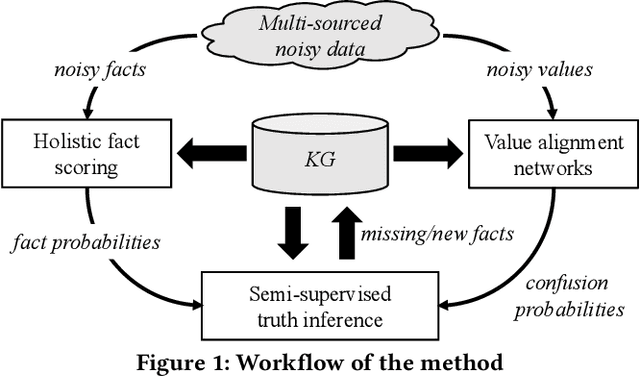
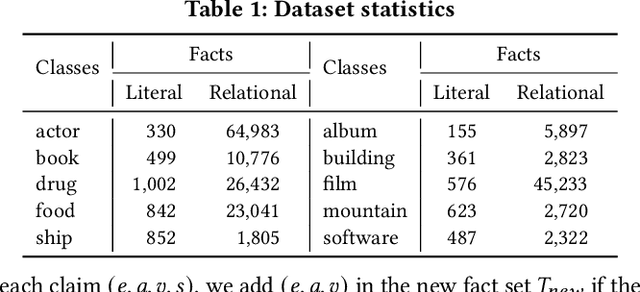
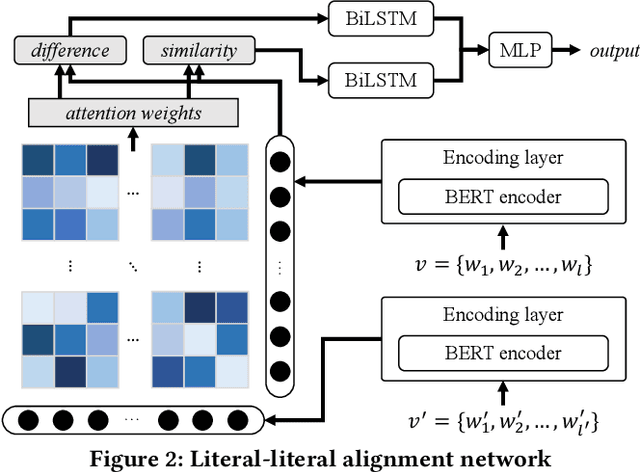
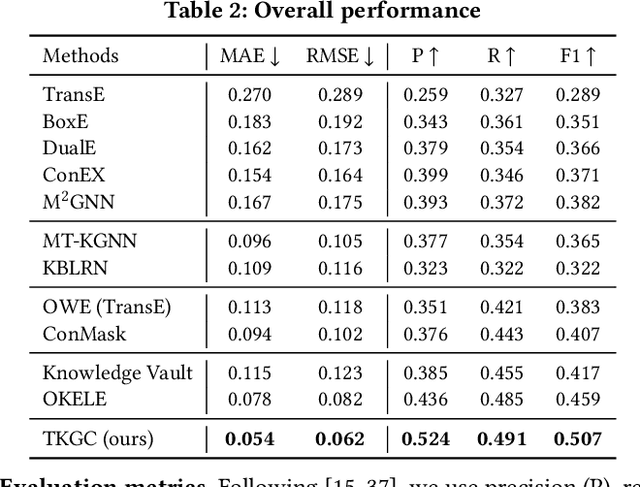
Abstract:Knowledge graphs (KGs) have become a valuable asset for many AI applications. Although some KGs contain plenty of facts, they are widely acknowledged as incomplete. To address this issue, many KG completion methods are proposed. Among them, open KG completion methods leverage the Web to find missing facts. However, noisy data collected from diverse sources may damage the completion accuracy. In this paper, we propose a new trustworthy method that exploits facts for a KG based on multi-sourced noisy data and existing facts in the KG. Specifically, we introduce a graph neural network with a holistic scoring function to judge the plausibility of facts with various value types. We design value alignment networks to resolve the heterogeneity between values and map them to entities even outside the KG. Furthermore, we present a truth inference model that incorporates data source qualities into the fact scoring function, and design a semi-supervised learning way to infer the truths from heterogeneous values. We conduct extensive experiments to compare our method with the state-of-the-arts. The results show that our method achieves superior accuracy not only in completing missing facts but also in discovering new facts.
Metapaths guided Neighbors aggregated Network for?Heterogeneous Graph Reasoning
Mar 11, 2021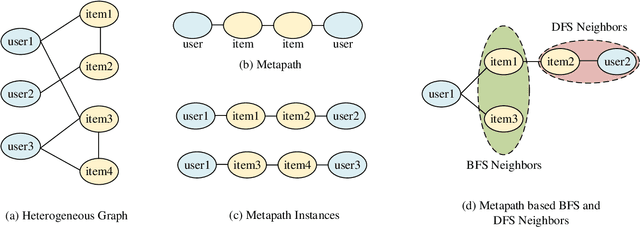
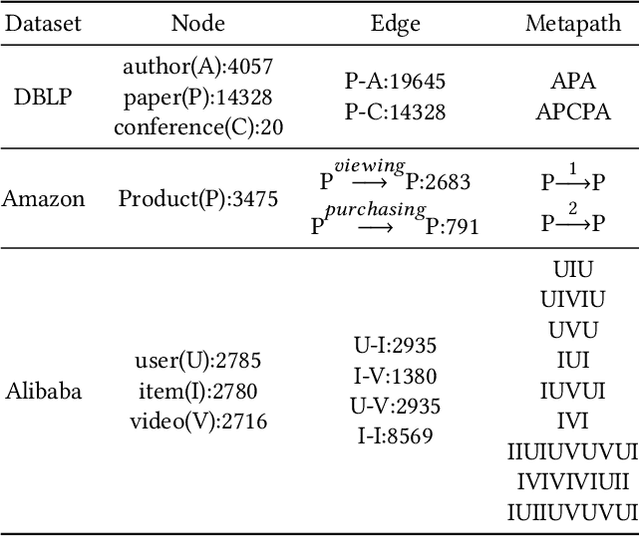
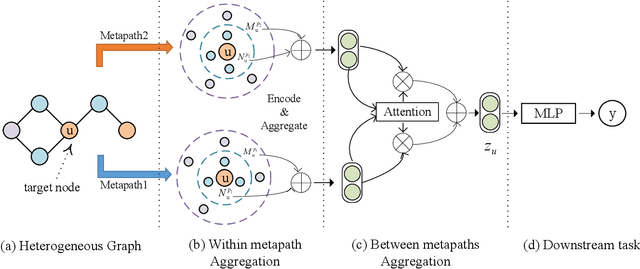

Abstract:Most real-world datasets are inherently heterogeneous graphs, which involve a diversity of node and relation types. Heterogeneous graph embedding is to learn the structure and semantic information from the graph, and then embed it into the low-dimensional node representation. Existing methods usually capture the composite relation of a heterogeneous graph by defining metapath, which represent a semantic of the graph. However, these methods either ignore node attributes, or discard the local and global information of the graph, or only consider one metapath. To address these limitations, we propose a Metapaths-guided Neighbors-aggregated Heterogeneous Graph Neural Network(MHN) to improve performance. Specially, MHN employs node base embedding to encapsulate node attributes, BFS and DFS neighbors aggregation within a metapath to capture local and global information, and metapaths aggregation to combine different semantics of the heterogeneous graph. We conduct extensive experiments for the proposed MHN on three real-world heterogeneous graph datasets, including node classification, link prediction and online A/B test on Alibaba mobile application. Results demonstrate that MHN performs better than other state-of-the-art baselines.
Transformer-based Language Model Fine-tuning Methods for COVID-19 Fake News Detection
Jan 18, 2021
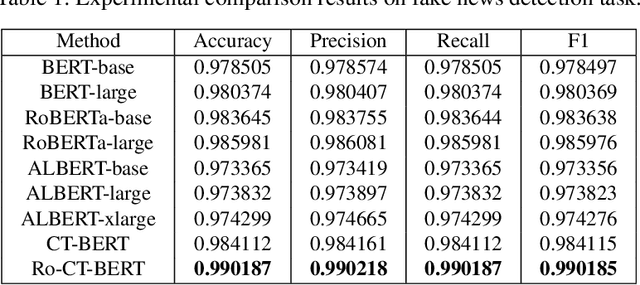

Abstract:With the pandemic of COVID-19, relevant fake news is spreading all over the sky throughout the social media. Believing in them without discrimination can cause great trouble to people's life. However, universal language models may perform weakly in these fake news detection for lack of large-scale annotated data and sufficient semantic understanding of domain-specific knowledge. While the model trained on corresponding corpora is also mediocre for insufficient learning. In this paper, we propose a novel transformer-based language model fine-tuning approach for these fake news detection. First, the token vocabulary of individual model is expanded for the actual semantics of professional phrases. Second, we adapt the heated-up softmax loss to distinguish the hard-mining samples, which are common for fake news because of the disambiguation of short text. Then, we involve adversarial training to improve the model's robustness. Last, the predicted features extracted by universal language model RoBERTa and domain-specific model CT-BERT are fused by one multiple layer perception to integrate fine-grained and high-level specific representations. Quantitative experimental results evaluated on existing COVID-19 fake news dataset show its superior performances compared to the state-of-the-art methods among various evaluation metrics. Furthermore, the best weighted average F1 score achieves 99.02%.
Spending Money Wisely: Online Electronic Coupon Allocation based on Real-Time User Intent Detection
Aug 23, 2020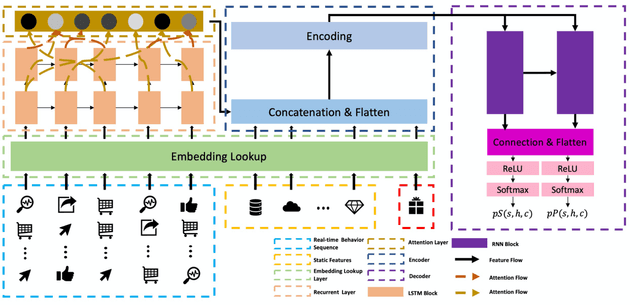
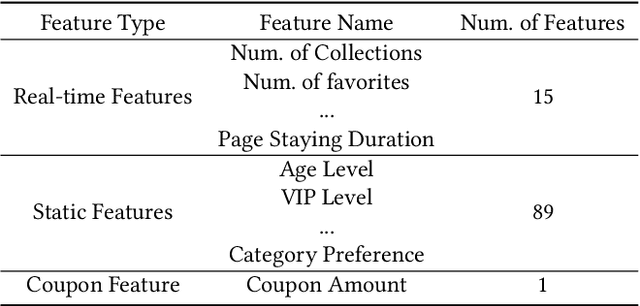
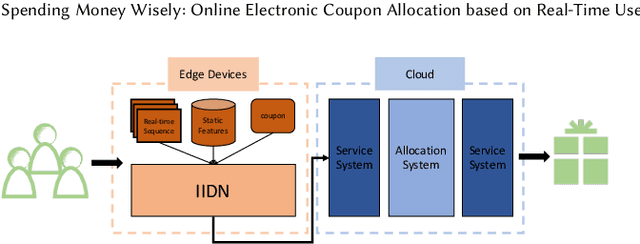
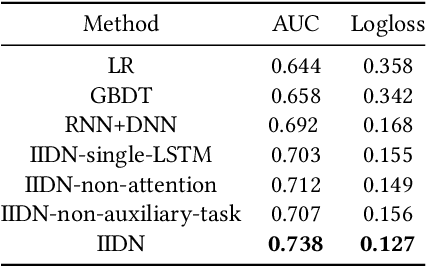
Abstract:Online electronic coupon (e-coupon) is becoming a primary tool for e-commerce platforms to attract users to place orders. E-coupons are the digital equivalent of traditional paper coupons which provide customers with discounts or gifts. One of the fundamental problems related is how to deliver e-coupons with minimal cost while users' willingness to place an order is maximized. We call this problem the coupon allocation problem. This is a non-trivial problem since the number of regular users on a mature e-platform often reaches hundreds of millions and the types of e-coupons to be allocated are often multiple. The policy space is extremely large and the online allocation has to satisfy a budget constraint. Besides, one can never observe the responses of one user under different policies which increases the uncertainty of the policy making process. Previous work fails to deal with these challenges. In this paper, we decompose the coupon allocation task into two subtasks: the user intent detection task and the allocation task. Accordingly, we propose a two-stage solution: at the first stage (detection stage), we put forward a novel Instantaneous Intent Detection Network (IIDN) which takes the user-coupon features as input and predicts user real-time intents; at the second stage (allocation stage), we model the allocation problem as a Multiple-Choice Knapsack Problem (MCKP) and provide a computational efficient allocation method using the intents predicted at the detection stage. We conduct extensive online and offline experiments and the results show the superiority of our proposed framework, which has brought great profits to the platform and continues to function online.
 Add to Chrome
Add to Chrome Add to Firefox
Add to Firefox Add to Edge
Add to Edge